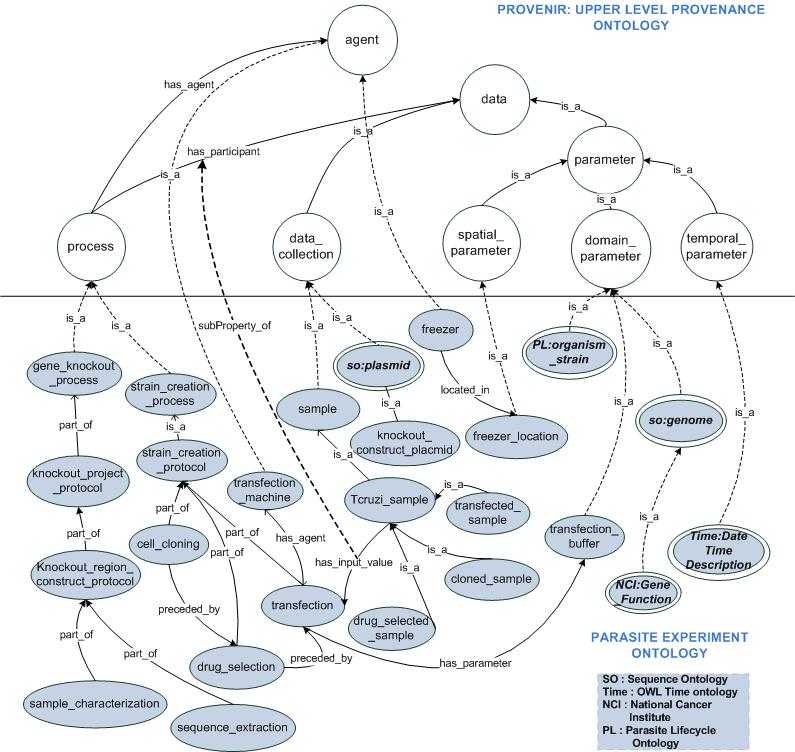Difference between revisions of "Biomedical Sciences"
From Knoesis wiki
| Line 1: | Line 1: | ||
The Provenir Ontology was used as upper level ontology to develop [[Parasite Experiment ontology |Parasite Experiment Ontology]] (PEO) for the NIH-funded T.cruzi Semantic Problem Solving Environment (SPSE) project. The PEO extends the classes and relationships in provenir ontology to model provenance information associated with experiment protocols for Gene Knockout (GKO), Strain Creation (SC), Microarray, and Proteome Analysis. These protocols consist of multiple sub-processes, which are modeled in PEO as different classes (Figure 1). The PEO forms schema to query semantically integrated parasite experimental datasets and databases using intuitive query processing tool, Cuebee. | The Provenir Ontology was used as upper level ontology to develop [[Parasite Experiment ontology |Parasite Experiment Ontology]] (PEO) for the NIH-funded T.cruzi Semantic Problem Solving Environment (SPSE) project. The PEO extends the classes and relationships in provenir ontology to model provenance information associated with experiment protocols for Gene Knockout (GKO), Strain Creation (SC), Microarray, and Proteome Analysis. These protocols consist of multiple sub-processes, which are modeled in PEO as different classes (Figure 1). The PEO forms schema to query semantically integrated parasite experimental datasets and databases using intuitive query processing tool, Cuebee. | ||
| − | [[Image: | + | [[Image:ExtendingProvenir.jpg| 400x| Figure: 1 Extension of PO to PEO]] |
'''Reference:''' | '''Reference:''' | ||
*S.S. Sahoo, D.B. Weatherly, R. Mutharaju, P. Anantharam, A. Sheth, R.L. Tarleton, “Ontology-driven Provenance Management in eScience: an Application in Parasite Research”, The 8th International Conference on Ontologies, DataBases, and Applications of Semantics, (ODBASE 2009), Vilamoura, Algarve-Portugal, Nov 02 - 04, 2009. | *S.S. Sahoo, D.B. Weatherly, R. Mutharaju, P. Anantharam, A. Sheth, R.L. Tarleton, “Ontology-driven Provenance Management in eScience: an Application in Parasite Research”, The 8th International Conference on Ontologies, DataBases, and Applications of Semantics, (ODBASE 2009), Vilamoura, Algarve-Portugal, Nov 02 - 04, 2009. | ||
Revision as of 15:08, 12 August 2010
The Provenir Ontology was used as upper level ontology to develop Parasite Experiment Ontology (PEO) for the NIH-funded T.cruzi Semantic Problem Solving Environment (SPSE) project. The PEO extends the classes and relationships in provenir ontology to model provenance information associated with experiment protocols for Gene Knockout (GKO), Strain Creation (SC), Microarray, and Proteome Analysis. These protocols consist of multiple sub-processes, which are modeled in PEO as different classes (Figure 1). The PEO forms schema to query semantically integrated parasite experimental datasets and databases using intuitive query processing tool, Cuebee.
Reference:
- S.S. Sahoo, D.B. Weatherly, R. Mutharaju, P. Anantharam, A. Sheth, R.L. Tarleton, “Ontology-driven Provenance Management in eScience: an Application in Parasite Research”, The 8th International Conference on Ontologies, DataBases, and Applications of Semantics, (ODBASE 2009), Vilamoura, Algarve-Portugal, Nov 02 - 04, 2009.
